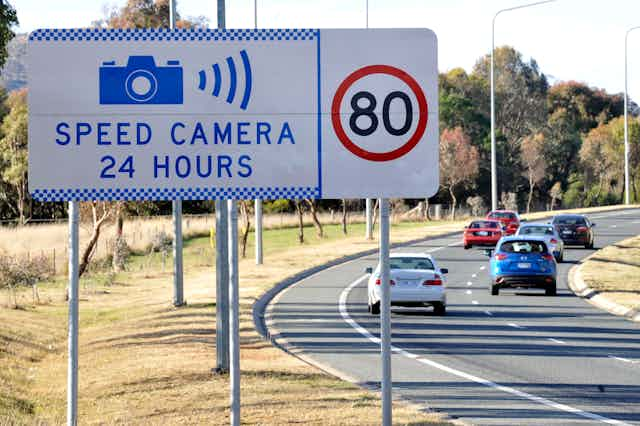After years of consistent progress, reductions in the road toll are plateauing in many countries. Australia’s road fatalities increased by 7.5% in 2016, and the number of fatalities per 100,000 population rose by 6%. This trend appears to be continuing in 2017.
Road trauma is already the ninth leading cause of death worldwide. It is estimated it will be one of the top five killers by 2030.
In efforts to stem road trauma, the global road safety community has promoted what it calls “safe systems” approaches. These cover:
-
improved road safety management;
safer roads;
safer vehicles;
safer road users; and
improved post-crash response systems.
In Queensland, enforcement and education campaigns aim to prevent the “fatal five” behaviours known to underpin road trauma:
drug and drink driving;
distraction and inattention;
failure to wear a seatbelt;
speeding; and
fatigue.
Assuming some drivers will still engage in these behaviours, efforts also focus on how vehicles, road environments and trauma and rehabilitation services can be modified to reduce the likelihood of death and serious injury in a crash.
This approach has achieved considerable, undeniable success. But it may have reached its limits of effectiveness.
Why isn’t this approach working any more?
Fundamentally, the current “safe systems” approach is based on reductionism: that is, the road transport system is artificially isolated from its broader environment and broken into even smaller, discrete parts (such as road users, vehicles and roads).
Attempts are then made to optimise these parts under the assumption that once they are all put back together, the system will naturally perform better.
But complex systems, which are far more than the sum of their parts, do not operate like that. Instead, modified parts interact with other parts in new ways and unexpected emergent behaviours can occur. Factors across the system might also resist change, bringing the modified parts back to their original state, or creating new issues that arise from previous solutions.
Finally, and perhaps most importantly, things extrinsic to the system itself can influence the behaviour of the individual parts.
For most people, driving is simply a means to an end, and something that is affected by the pressures of life and work. There are wider societal issues driving road user behaviour that a traditional road safety approach cannot fix.
For example, take driving under the influence of illicit or prescription drugs, which is an emerging road safety problem.
Drug misuse and addiction are both societal issues that road safety authorities attempt to manage through enforcement and education campaigns. But the current road safety approach does not tackle the underlying issue of drug misuse and addiction. Rather, it simply identifies and removes drug-affected drivers from the road.
This approach is based on causal loop logic, such as that presented below. The diagram suggests a mechanism whereby drug-related crashes and fatalities lead to policy action, which then drives increased enforcement.
The diagram illustrates the belief that identifying drug-affected drivers and removing them from the road will lead to a decrease in the number of drug-affected drivers and related crashes.
But what’s important to note in this representation is that nowhere are societal problems of drug misuse and addiction tackled.

Although drug-affected drivers will continue to be caught and penalised, they are not rehabilitated, and little is done to tackle wider societal issues that contribute to drug misuse and addiction. As such, we can only expect a continued flow of drug-affected drivers onto our roads.
The same applies for other “fatal five” behaviours, which each have societal drivers. For example, increasing levels of alcohol consumption influence drink-driving rates, an increasing desire to remain connected through mobile phones influences distraction and inattention, increasingly time-poor lifestyles lead to speeding, and work pressures lead to fatigued driving.
Even the very requirement to drive a car in the first place is driven by low-density urban form and lack of viable public transport.
What is the solution?
The safe-systems view of road safety, which defines the boundaries of the road system as drivers, vehicles and roads, has largely run its course.
A new, systems-thinking-based approach is required that considers the broader societal systems whose effects manifest inside the road system. This requires the breakdown of silos between the fields of public health, workplace safety, urban planning and road safety.
With drug driving, for example, road safety stakeholders should co-ordinate their activities with those tackling drug misuse and addiction.
In the case of prescription drugs, government, the media, drug manufacturers, pharmaceutical companies, doctors, healthcare providers and the police should all be working together through active collaboration.
Prescription rates, drug packaging, alternative pain treatments and rehabilitation should be co-ordinated with modifications to road safety strategy, road rules and regulations, licensing, road user testing, education and enforcement.
This systems-thinking approach is represented below. The earlier causal loop diagram has been modified to show some of the wider influences on, and potential solutions for, drug-driving.

Encouragingly, there is a groundswell of research that is beginning to apply systems-thinking methods to road safety. Researchers and practitioners are realising the need to look beyond the road transport system and work with those in other areas.
While we should not forget the significant and tangible impact that road safety stakeholders have achieved, it’s time to acknowledge that road trauma is a complex problem that cannot be solved by them alone.

